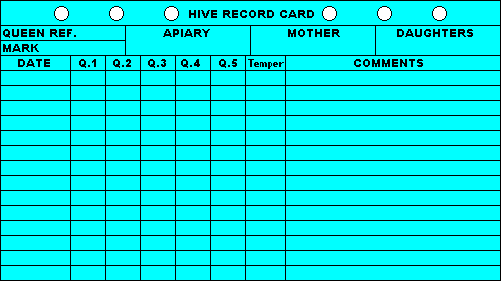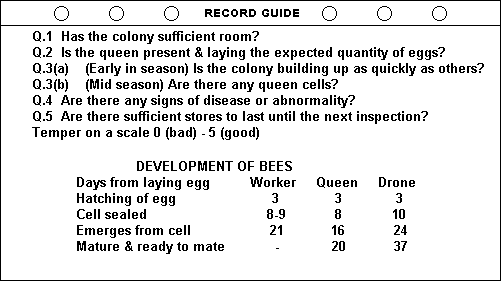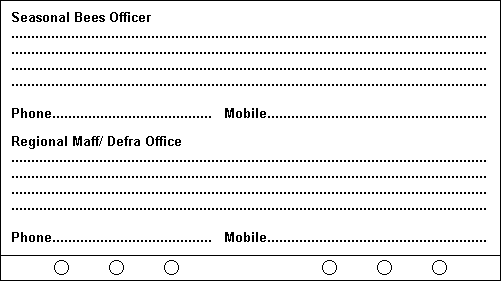| |
Chris Slade's Colony Assessment Record Card
The Honey bee colony assessment record card developed by Chris Slade are designed
to be used in a 6 ring binder of the standard Filofax type and are 180 mm wide x
100 mm tall.
|
|---|
Chris... (who has written this description) gets a new set
printed each year in the appropriate colour
for the year. That is:-
years ending 1 or 6... white,
2 or 7... yellow, 3 or
8... red,
4 or 9... green, 5 or 0... blue.
This is not essential, but it makes
the cards of old queens stand out.
Ensure that the printer prints the
reverse side upside down and in register with the front side. You can
get 2 cards to an A4 card and they need trimming to size with a paper
trimmer. They work out at about 5 pence each. The holes are punched
with a Filofax hole punch available from stationers.
| |

|
|---|
There are two additional cards that go at the front of the
pack. The first is a reminder of the questions to be asked every time
a hive is opened. They are to be found in Ted Hooper's "Guide to Bees
& Honey" and are as follows:-
|
Q1 | Has the colony sufficient room? |
|---|
| Q2 | Is the queen present and laying the expected quantity of eggs? |
|---|
| Q3a | (Early in season) Is the colony building up as quickly as others? |
|---|
| Q3b | (Mid season) Are there any queen cells? |
|---|
| Q4 | Are there any signs of disease or abnormality? |
|---|
| Q5 | Are there sufficient stores to last until the next inspection? |
|---|
| Temper | scored on a scale 0 (they saw me off) - 5 no
gloves, no smoke, no stings
|
|---|
Mostly the answers are noted with a simple tick in the box.
This can be varied with a simple code, for instance an M under Q2
means the marked queen was seen or CB under Q4 means Chalk Brood.
There is room on this card for an aide memoir on Development
of Bees in tabular form for both castes and genders and for the name
and phone number of the local Foul Brood Officer (which is on the rear of the card).
The rear of this front card is shown in the diagram below.
| |

|
|---|

The second additional card is a simple list with the serial number of
the queen and the location of the hive she is in. Note that it is the
queen that is numbered and not the hive. This makes it easier to keep
track of family trees on the female side.
The layout of a suitable queen/location listing is shown below and the
card should have identical printing on it's reverse for more colonies. If even
more colonies are to be recorded then extra cards can be added.
| |

|
|---|
There are various ways of measuring hygiene if one wishes. Simply,
one kills a number of larvae within sealed cells by freezing or with
a needle, replaces the comb in the hive and, 24 hours later counts
the number uncapped and removed and converts it into a percentage for
scoring. Hygiene is thought by some to make the colony less
susceptible to a number of pests and diseases.
Economy can be assessed by weighing the honey crop and
deducting sugar fed. Alternatively, as over wintering economy is most
important, one can weigh a hive when michaelmas daisies are in flower
and again when it is dandelion wine time and compare.
If you wish to improve your stock, the last line is the most
important, particularly the last word - CULL. (That is Chris's Emphasis on the
last word and I also wish to stress even further that records are no use unless
you act on what they tell you and that means culling the bad as well as
selecting the good.)
The rear of the card allows for overall collation of all
examinations to give a figure for comparison to other colonies.
If you download this item and print it for your own use, I
do not think that Chris will object, but please remember that it is
Chris's idea.
The card(s) itself (themselves) can be filed for permanent record
purposes.
| |

|
|---|
Page generated... 28 August 2001,
Revised... 19 January 2002,
Spellchecked... 11 April 2002,
Upgraded... 08 October 2004,
Further Upgraded... 17 June 2005,
Revised... 11 January 2007,
|




